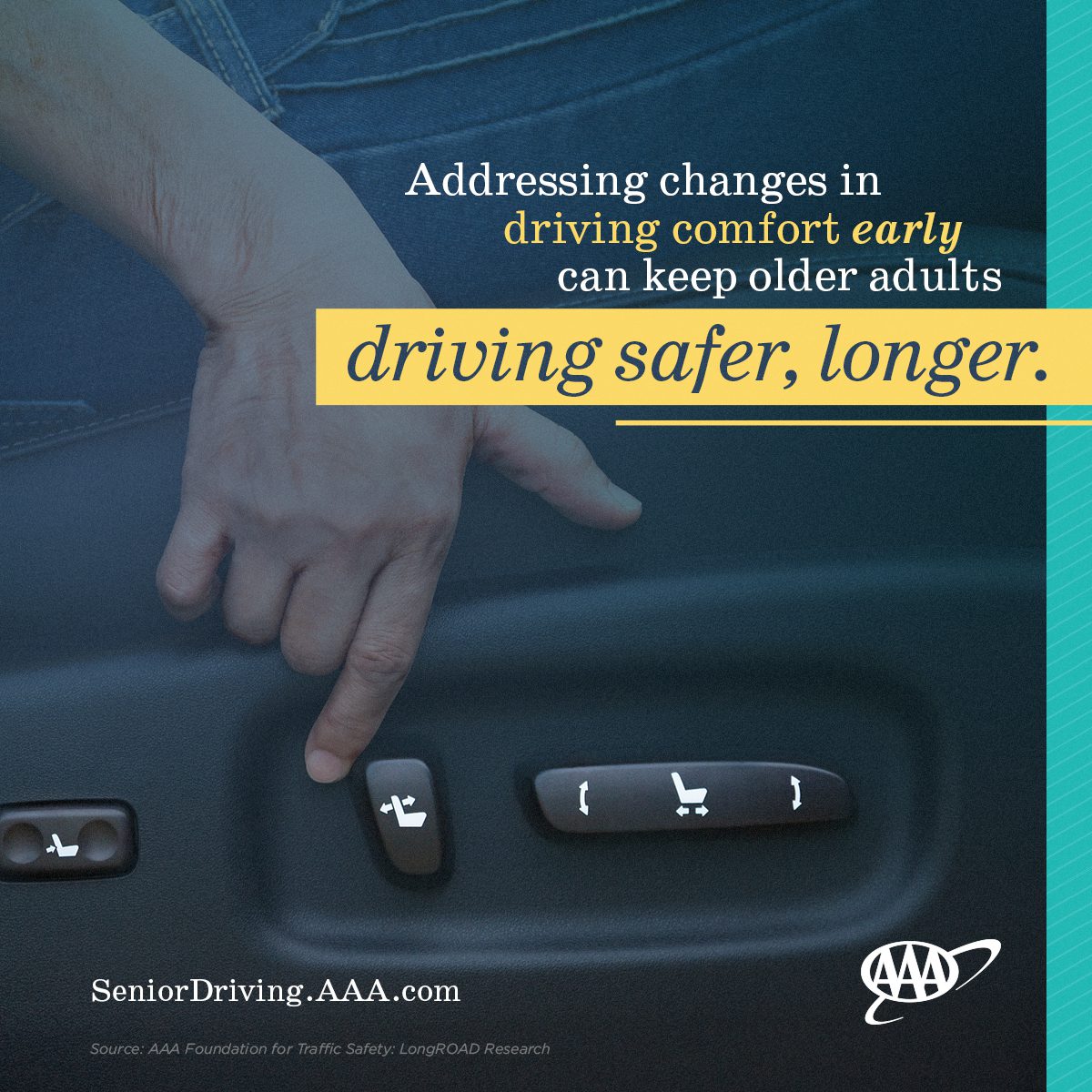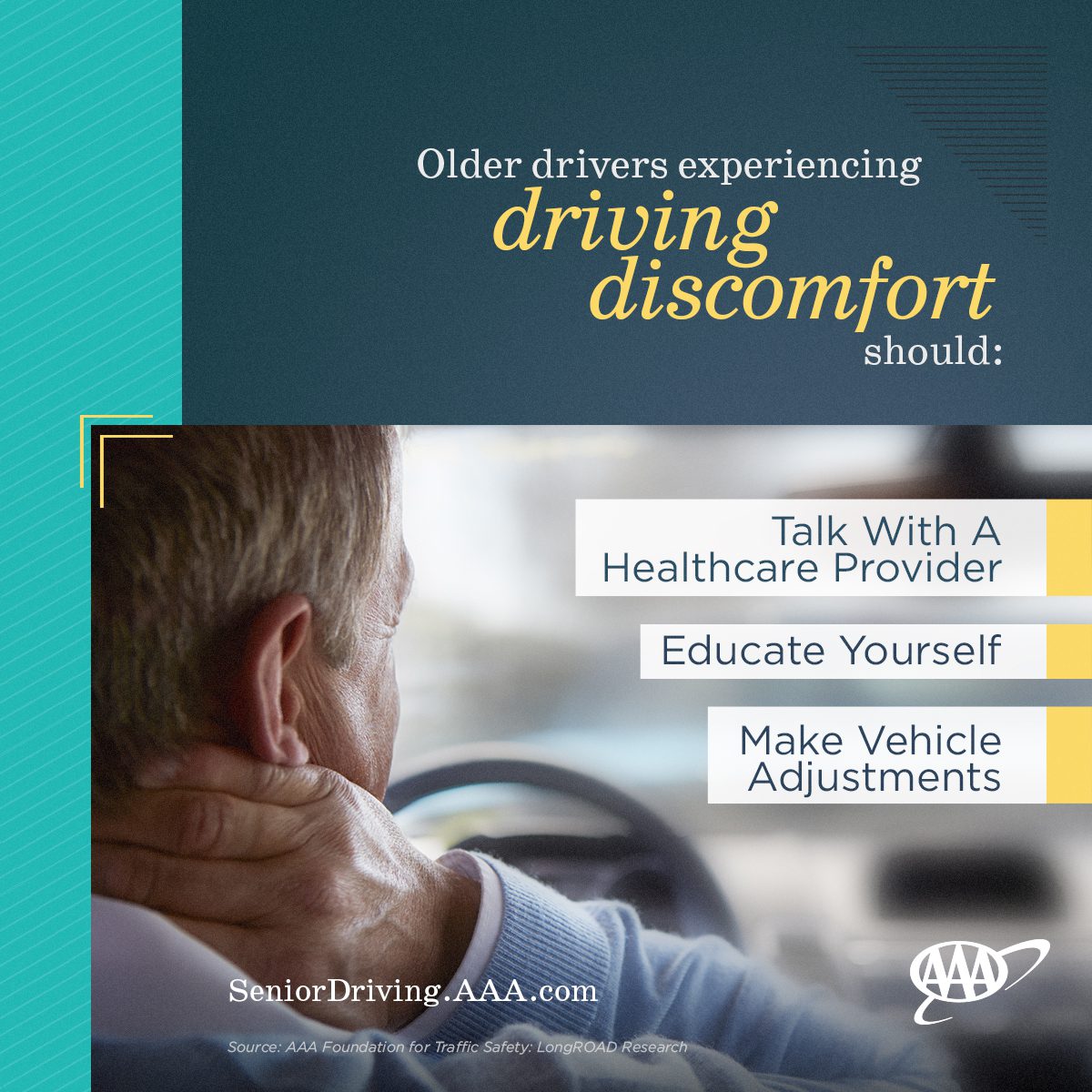PORTLAND, Ore., – Older adults who are uncomfortable in certain driving conditions are adjusting their driving patterns to avoid driving at night, on the freeway, in afternoon rush hour traffic, or in unfamiliar areas, according to new research from the AAA Foundation for Traffic Safety. Some of the self-regulated changes older drivers make can be unnecessary and do not always improve safety. In order to extend their mobility and reduce risk on the road, AAA recommends older drivers consult a healthcare professional when feelings of driving discomfort arise.
“When older drivers become uncomfortable in certain driving situations, some may assume they have to live with the discomfort while others unnecessarily reduce their mobility,” said Dr. David Yang, executive director of the AAA Foundation for Traffic Safety. “By addressing issues of discomfort early, older drivers can learn more about age-related changes to their body and discuss strategies with their healthcare provider to best compensate for declines.”
Researchers from the AAA Foundation for Traffic Safety partnered with the University of Michigan Transportation Research Institute (UMTRI) to evaluate how an older drivers’ (ages 65 – 79) comfort level on the road affects their driving behaviors. Using GPS data loggers to track driving patterns, they found that older drivers who report lower comfort driving at night, during afternoon rush hour, on the freeway and in unfamiliar areas also self-regulated their behavior to reduce or avoid driving in those situations.
While self-regulation is often the best solution to allow older drivers to continue driving safely, some changes can create unintended consequences on the roadway. For example, using side streets to avoid the freeway can also increase an older drivers’ risk of a crash by increasing the distance traveled and their exposure on the road.
“Older drivers should not let physical discomfort and low confidence limit their mobility or safety. The key is to speak up. Your health care provider may help you find ways to address these issues,” says Marie Dodds, public affairs director for AAA Oregon/Idaho. “Something as simple as adjustments to your vehicle, a driver refresher course, or a change in medications can improve older drivers’ comfort and safety behind the wheel.”
When older drivers begin to experience physical changes to the body or feelings of driving discomfort, AAA recommends:
- Talk About It: Visit a doctor or occupational therapy driver rehabilitation specialist to determine the cause of your discomfort and evaluate potential solutions.
- Educate Yourself: You can evaluate your driving performance using tools like AAA’s Driver65Plus to determine your strengths and weaknesses and learn ways to improve your driving. Consider taking a driver improvement course to help refresh your driving knowledge, get the most out of your vehicle and reduce risk on the road.
- Make Changes: Once you know the cause of your discomfort, make needed vehicle adjustments. Free programs like CarFit can help older drivers learn about changes they can make to their vehicle to better fit their needs.
For more information on AAA resources for older drivers, such as RoadWise online/classroom courses or other programs that help seniors better “fit” with their vehicles, visit www.SeniorDriving.AAA.com.
About LongROAD: Recognizing that lifestyle changes, and innovative technologies and medical advancements will have a significant impact on the driving experiences of the baby boomer generation, the AAA Foundation for Traffic Safety launched a ground-breaking, multi-year research program to more fully understand and meet the safety and mobility needs of older drivers in the United States. The AAA LongROAD (Longitudinal Research on Aging Drivers) is one of the largest and most comprehensive studies available on senior drivers with 2,990 participants being followed for five years. It will support in-depth studies of senior driving and mobility to better understand risks and develop effective countermeasures.
About AAA Foundation for Traffic Safety: Established in 1947 by AAA, the AAA Foundation for Traffic Safety is a not-for-profit, publicly funded, 501(c)(3) charitable research and educational organization. The AAA Foundation’s mission is to prevent traffic deaths and injuries by conducting research into their causes and by educating the public about strategies to prevent crashes and reduce injuries when they do occur. This research is used to develop educational materials for drivers, pedestrians, bicyclists and other road users. Visit www.AAAFoundation.org.
AAA provides more than 60 million members with automotive, travel, insurance and financial services through its federation of 34 motor clubs and more than 1,000 branch offices across North America. Since 1902, the not-for-profit, fully tax-paying AAA has been a leader and advocate for safe mobility. Drivers can request roadside assistance, identify nearby gas prices, locate discounts, book a hotel or map a route via the AAA Mobile app. To join, visit AAA.com.
AAA news releases, high resolution images, broadcast-quality video, fact sheets and podcasts are available on the AAA NewsRoom at NewsRoom.AAA.com.



